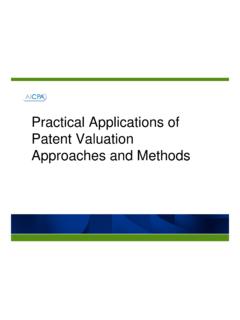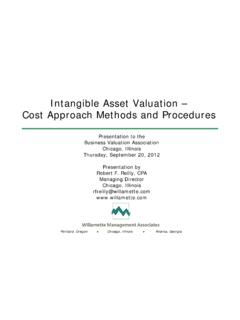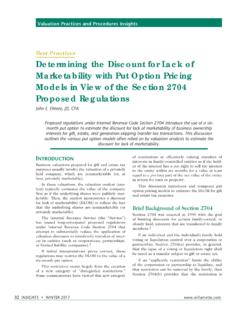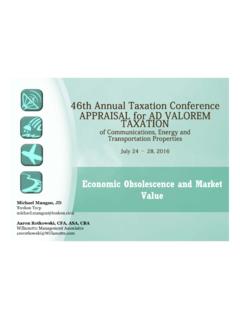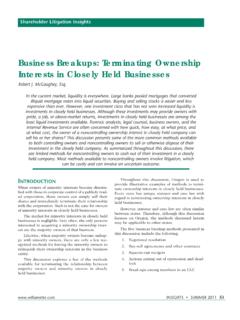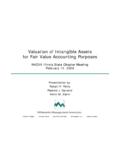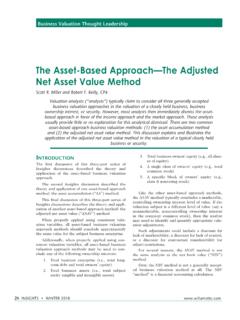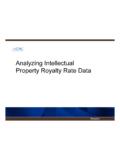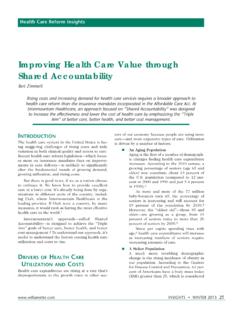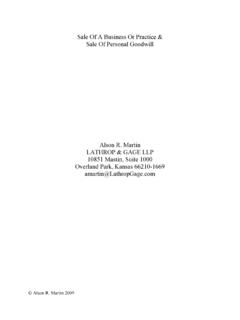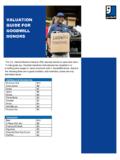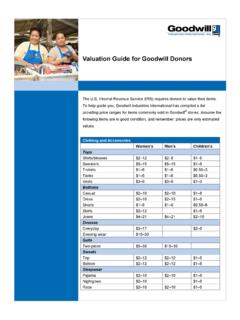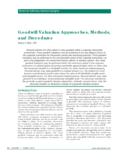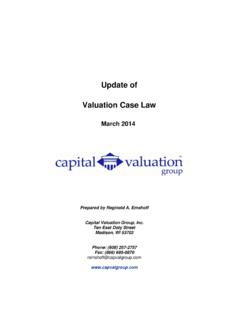Transcription of Distinguishing Personal Goodwill from Entity Goodwill in ...
1 54 INSIGHTS WINTER 2016 www .willamette .comintroductionThis discussion focuses primarily on the valuation of the closely held (or family-owned) company. Primarily, but not exclusively, this discussion focus-es on the valuation of a closely held C corporation that is managed by its particular, this discussion focuses on the question of how much of the total business enter-prise value relates to the Personal Goodwill of the company are numerous gift tax, estate tax, generation-skipping transfer tax, and income tax reasons why valuation analysts may be asked to allocate the subject business enterprise total intangible asset value between (1)
2 The company s Entity Goodwill and (2) the individual shareholder/employee s Personal discussion is informed by the recent Tax Court decision in Bross Trucking, Inc., et al. v. Commissioner of Internal Revenue1 (the Bross Trucking decision ).There are several instances when it is important for a closely held corporation (and for its owners) to distinguish between:1. the Personal Goodwill (owned by the indi-vidual shareholder/employees) and2. the Entity Goodwill (owned by the company itself).The first instance typically relates to the formation of the closely held company.
3 In many closely held corporation formations, individual shareholder/employees transfer their Personal Goodwill to the newly formed corporation in exchange for newly issued shares of the corporation transfers of Personal Goodwill may qualify as a tax-deferred exchange (of Personal Goodwill for corporation stock) under Internal Revenue Code Section alternative tax treatment (when Personal Goodwill is not transferred) is to treat the issuance of the corporation stock as taxable equity-based com-pensation for the shareholder/employee s sweat equity in the newly formed second instance may involve the conversion of the closely held C corporation to a closely held S corporation.
4 In such a tax status conversion Estate Planning InsightsDistinguishing Personal Goodwill from Entity Goodwill in the valuation of a Closely Held CorporationRobert F. Reilly, CPAThe valuation of a closely held corporation often has gift tax, estate tax, and generation-skipping transfer tax implications. In addition, the valuation of a closely held corporation often has income tax implications. In these tax-related instances, it is often important for the business owners (and for their professional advisers) to allocate the total enterprise value (or the total transaction consideration) between (1) the company-owned Entity Goodwill and (2) the individual shareholder/employee-owned Personal Goodwill .
5 This discussion summarizes the valuation analyst considerations with regard to the elements of, the separability of, and the documentation of a shareholder/employee s Personal .willamette .com INSIGHTS WINTER 2016 55transaction, the C corporation assets are valued on the date of the tax status the S corporation is then sold during the term of the Section 1374 built-in gain recognition period, that corporation would have to pay tax on any gain ( , the amount of the sale price over the tax basis of the company assets).However, any assets that are owned outside of the C corporation (such as the shareholder/employee s Personal Goodwill ) would not be part of the corporation s tax status , the amount of any Personal Goodwill that would be transferred along with the sale of the (now) S corporation would not be subject to the Section 1374 built-in gain recognition.
6 Of course, the individual shareholder/employee would still recognize one level of tax on the sale of his or her Personal third instance is the most common instance, and it relates to the sale (structured as an asset sale)of the closely held corporation. In such a sale, the business sale transaction would be structured as (and the deal documents should reflect) two sepa-rate transfers:1. The sale of the closely held corporation assets2. The sale of the shareholder/employee s Personal goodwillThe sale of the assets of the C corporation will likely be subject to two levels of taxation: (1) once at the corporation level for the sale of any appreci-ated (sale price in excess of tax basis) assets and (2) again at the shareholder level related to the distribu-tion of the after-corporate-tax sale proceeds to the individual , the shareholder s sale of any Personal Goodwill should be subject to only one level of taxa-tion.
7 This is because the individual shareholder is selling his or her Personal Goodwill directly to the business addition, any gain on the sale of the share-holder/employee s Personal Goodwill would typically be considered a capital gain, subject to preferential capital gains tax treatment. The capital gain treat-ment assumes that the Personal Goodwill was owned by the individual shareholder/employee for more than 12 fourth instance relates to other transfers of the closely held corporation stock or of the Personal transfers could occur in a gift tax, estate tax, or generation-skipping transfer tax situation.
8 Such situations depend on:1. which assets ( Personal Goodwill , Entity Goodwill , or other assets) were transferred,2. who transferred and who received the trans-ferred assets, and3. the valuation of the transferred Bross Trucking decision relates to such a set of circumstances. The Internal Revenue Service (the Service ) claimed that the owner of Bross Trucking Company, Inc. ( Bross Trucking ) made a gift of transferred Goodwill to a new company formed by his three on the Tax Court s judicial guidance pro-vided in the Bross Trucking decision, this discus-sion considers:1.
9 The elements that demonstrate the existence of an individual shareholder/employee s Personal Goodwill ,2. the factors that differentiate the existence (and transfer) of Personal Goodwill from the existence (and transfer) of Entity Goodwill , and3. the components of the transaction (and of the deal documentation) that indicate the transfer of Personal Goodwill as part of the overall closely held business sale Bross Trucking dEcisionIn the Bross Trucking decision, the Tax Court con-cluded that a trucking company owned by Chester Bross ( Chester ) did not distribute Goodwill to Chester who, in turn, did not transfer the Goodwill to a newly formed trucking company owned by Chester s three name of the sons trucking company was LWK Trucking Co.
10 , Inc. (LWK).Therefore, the Tax Court determined that Chester owed no gift tax with regard to any transfers to LWK or to his three the Bross Trucking decision, Chester owned a road construction company. Chester also orga-nized several other companies to provide ser-vices and equipment to his construction company. Chester was knowledgeable about the construc-tion industry, and he had developed important relationships with government entities and other created Bross Trucking, a wholly owned company, to haul construction-related materials and equipment for road construction projects.
